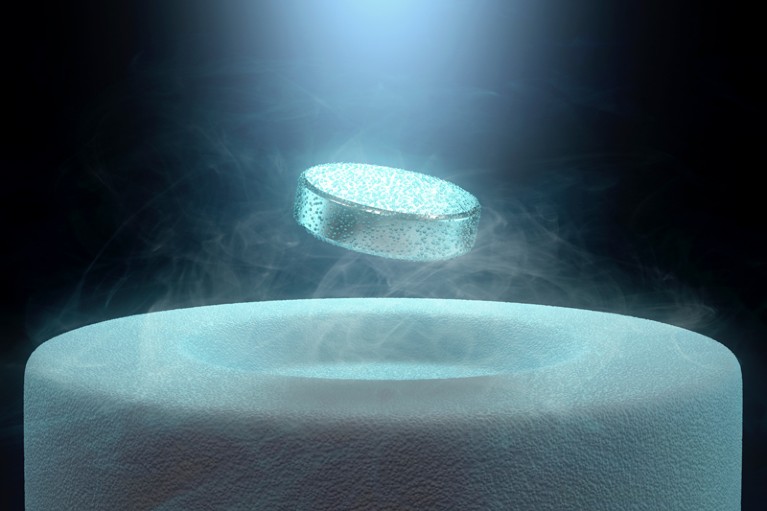[ad_1]

A magnet levitating over a cryogenically cooled superconductor (artist’s concept).Credit: KTSDesign/Science Photo Library
A high-profile study in which researchers claimed to have observed the first true room-temperature superconductor has been retracted.
Physicist Ranga Dias at the University of Rochester in New York State and his collaborators stirred interest but also caution with a 2020 Nature paper1 that reported the creation of a superconductor that worked at an unprecedented temperature of 15 ˚C. The material was a mix of carbon, hydrogen and sulfur, but to conduct electricity without resistance it had to be squeezed between two diamond tips to 2.6 million times greater than atmospheric pressure.
Superconductors can carry large electric currents without producing any waste heat, and are key to many scientific and medical applications, as well as potentially to future energy-saving technologies. But most superconductors work only at temperatures approaching absolute zero (–273 ˚C). Only in recent years have physicists managed to get some to work above 0 ˚C using high-pressure anvils.
Dias’s team “used a non-standard, user-defined procedure” in subtracting noise from experimental data shown in two figures, according to the retraction notice published2 on 26 September. “The details of the procedure were not specified in the paper and the validity of the background subtraction has subsequently been called into question.”
Through a spokesperson, Dias said that he and his colleagues disagree with the retraction and stand by their results. They will resubmit the paper to Nature with the raw-data plots of the figures. “The retraction request does not question the observed physical superconductivity state of the [carbon-sulfur-hydrogen] material,” says Dias’s statement. He pointed to an arXiv preprint posted4 in 2021 that responds to researchers’ concerns and presented the raw data, and added that three teams had replicated elements of the results.
The retraction follows the publication in Nature of a response4 to the original paper by physicists Jorge Hirsch of the University of California, San Diego, and Frank Marsiglio at the University of Alberta in Edmonton, Canada. The two had raised multiple questions about the study, in particular regarding the two figures mentioned in the retraction notice. These reported a drop in a feature called magnetic susceptibility when the material was cooled below a critical temperature — which is supposed to be a tell-tale sign of superconductivity. Several other publications had also questioned the claim, as did other physicists who pointed out some of these same issues in interviews with Nature’s news team at the time of the original publication.
“The retraction is dramatic but the correct decision,” says Mikhail Eremets, a physicist at the Max Planck Institute for Chemistry in Mainz, Germany, of the retraction. The field will now be able to move on from what has been a two-year-long controversy, he adds. “Scientists will have more time to work on real stuff.” Eremets’s laboratory has tried, unsuccessfully, to reproduce the results by Dias’s team, and he and his co-authors had already decided to stop citing the now-retracted paper.
[ad_2]
Source link
